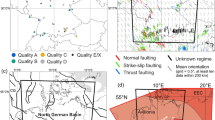Abstract
The boundary-element method is used for studying the stress state of rocks in the vicinity of the extensive cavity with gas depending on the actual gravitational and tectonic forces, gas pressure, as well as deposit geometry. The pressure value, up to which the field can be developed safely, is estimated; the possible mechanisms of enclosing mass deformation are examined.
Similar content being viewed by others
REFERENCES
S. N. Savchenko and A. I. Kalashnik, “To the problem of geomechanical development and exploitation of hydrocarbon deposits on the Barents Sea shelf,” in: Problems of Mineral Mining and Development of Underground Space in the North-West of Russia [in Russian], Kola Scientific Center, Apatity (2001).
S. Krauch and A. Starfield, Boundary-Element Method in Mechanics of Rigid Body [Russian translation], Mir, Moscow (1987).
S. P. Timoshenko and S. Voinovsky-Kriger, Plates and Shalls [Russian translation], G. S. Shapiro (ed.), Gos. Izd. Fiz.-Mat. Literatury, Moscow (1963).
Author information
Authors and Affiliations
Rights and permissions
About this article
Cite this article
Savchenko, S.N., Kalashnik, A.I. Estimate of the Stress State of Rocks in the Vicinity of Gas-Condensate Field on the Sea Shelf. Journal of Mining Science 37, 384–391 (2001). https://doi.org/10.1023/A:1014220606830
Issue Date:
DOI: https://doi.org/10.1023/A:1014220606830



